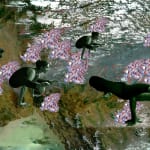



Sheba Chhachhi
Further images
The Ambiguous Gifts of Nature
I invite four yogic postures, Kukkutasan, Kakasan, Garudasan, and Pinchmayurasana, as protagonists to perform this continuing inquiry into forms of reciprocity between the human and the non-human. The scene is set against a backdrop of recent ecological disasters in Asia. Developed from deep observation of flora and fauna, the practice of Hatha Yoga asanas (body posture) can be understood as an internalizing of the somatic apparatus of other life forms. The practitioner becomes a heron, tree, cow, fish, bee, lion, monkey, or cobra to name just a few, by imaginatively and physically inhabiting the mode of knowing/being of non-humans who belong to a shared habitat. A gift received from the natural world.
However, this individualized mode of transformation morphs into privatized fitness regimes and the blurred, porous boundary between human and non-human ossifies. The dominant form of relationship with the non-human that remains is one of incorporation, the literal taking into one’s body, of the other that pivots around edibility. Birds are poultry, humans are subject to a kind of hyperphagia.
The gift is consumed.
A woman in Kukkut (rooster) and a man in Kak (crow) Asana vault over islands of red-wattled legless hens roosting in a NASA sensor's digital-photo-like image of severe drought in Myanmar. Each flash of red in this sumptuous eye-in-the-sky vision of Southeast Asia, taken in the spring of 2005, marks a forest fire.
Translucent dead chicks glide over the erect figure of a woman in Garudasana, the posture of the mythical hybrid eagle. Behind her, the devastated city of Balakot gleams in yet another gorgeous image of natural disasters produced by the Earth Observatory.
In the third animated lightbox of this triptych, Pinchamayurasana, the peacock feather posture, curves across the exquisitely rendered aerial view of the Gangetic plain inundated by floods. A brace of pheasants follows the arc, appearing and disappearing between the delicate tracery of rivers and tributaries.
What are named as ‘natural disasters’ are rendered beautiful and remote.
Satellite images, Google maps, and spectral imagery of water and land resources, created by visual technologies tied to surveillance and military use, technologies of seeing devoid of human agency, have superseded previous modes of representing the earth. This triptych presents a set of fluid conditions of interrelatedness, between remote sensing imagery and forms of exchange between humans and the rest of the phenomenal world.




